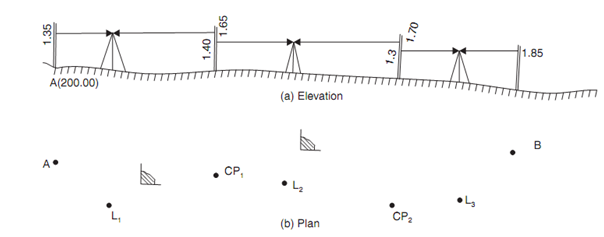Differential Levelling
From a single setting it may not be possible to take the readings on A and B if the distance between two points A and B is large.
In such case differential levelling is used. The instrument is set at more than one position, in differential levelling by a change point each shifting facilitated. Given figure shows a scheme of such setting.

RL of A is 200.00 m. At L1the instrument is set up and back sight on A is 1.35 m. Fore sight on change point CP1 is 1.65 m ,the instrument is shifted to L2 and back sight on CP1 is 1.40 m. Fore sight on CP2 is 1.70 m. CP2 is 1.3 m after this instrument is shifted to L3 and back sight on. The work is ended with a fore sight of 1.85 m on B. The RL of B is to be found.
RL of A = 200.00 m
Back sight on A = 1.35 m
∴ Plane of collimation at L1 = 200 + 1.35 = 201.35 m
Fore sight on CP1 = 1.65 m
∴ RL of CP1 = 201.35 - 1.65 = 199.70 m
Back sight to CP1 from L2 = 1.40
∴ Plane of collimation at L2 = 199.70 + 1.40 = 201.10 m
Fore sight to CP2 = 1.70 m
∴ RL of CP2 = 201.10 - 1.70 = 199.40 m
Back sight to CP2 from L3 = 1.30 m
∴ Plane of collimation at L3 = 199.40 + 1.30 = 200.70 m
Fore sight to B = 1.85 m
∴ RL of B = 200.70 - 1.85 = 198.85 m Ans.
If there are intermediary sight to the points E1 and E2, the RL of those points can be get by subtracting readings for E1 and E2 from the equivalent plane of collimations.